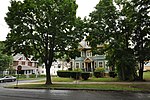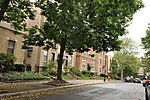Oxford-Whitney Streets Historic District
Colonial Revival architecture in ConnecticutHistoric districts in Hartford County, ConnecticutHistoric districts on the National Register of Historic Places in ConnecticutNRHP infobox with nocatNational Register of Historic Places in Hartford, Connecticut

The Oxford-Whitney Streets District is a historic district encompassing an early-20th century residential area in the West End neighborhood of Hartford, Connecticut. It extends along the east side of Oxford Street between Elizabeth and Cone Streets, and along the west side of Whitney between Fern and Elizabeth, and includes the north side of Fern Street between Whitney and Oxford. Most of the housing, a combination of single and multi-family residences, was built between 1906 and 1919, a period later than the surrounding areas, and is predominantly Colonial Revival in character. It was listed on the National Register of Historic Places in 2010.
Excerpt from the Wikipedia article Oxford-Whitney Streets Historic District (License: CC BY-SA 3.0, Authors, Images).Oxford-Whitney Streets Historic District
Fern Street, Hartford
Geographical coordinates (GPS) Address External links Nearby Places Show on map
Geographical coordinates (GPS)
| Latitude | Longitude |
|---|---|
| N 41.770277777778 ° | E -72.713611111111 ° |
Address
Oxford–Whitney Streets Historic District
Fern Street
06107 Hartford
Connecticut, United States
Open on Google Maps










